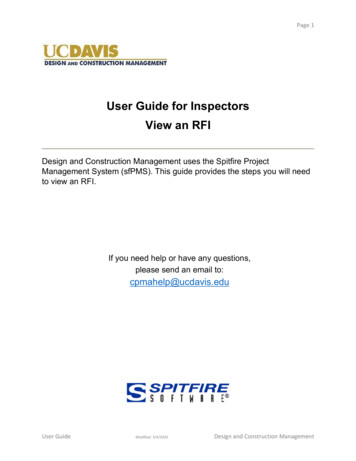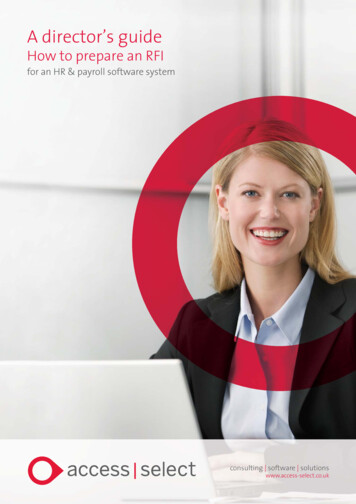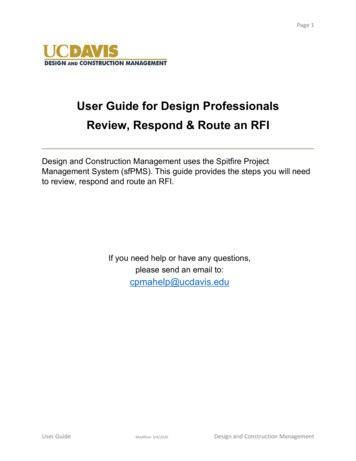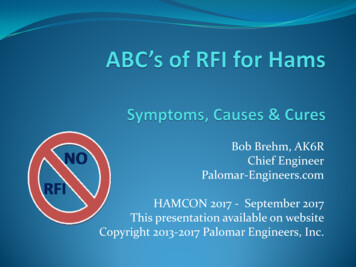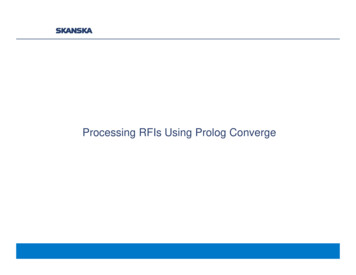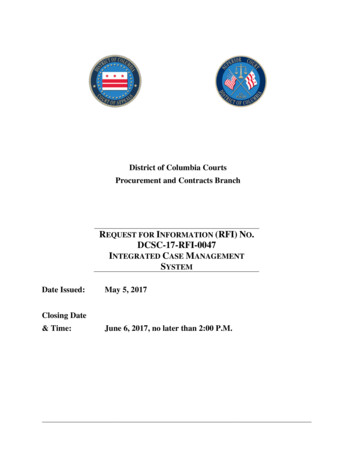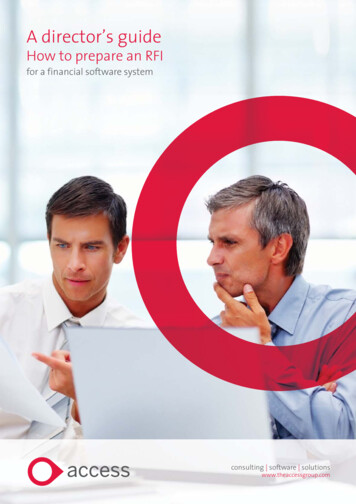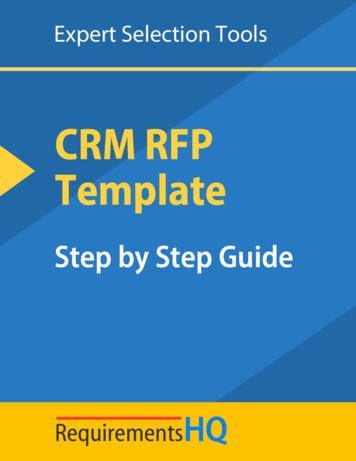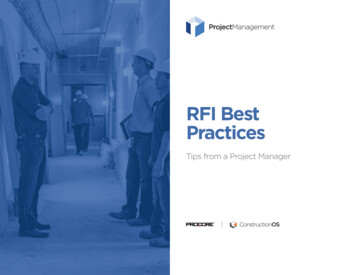
Transcription
RFI BestPracticesTips from a Project Manager
RFI BEST PRACTICES: TIPS FROM A PROJECT MANAGER2Looking back to ancient architecture, its unlikely that the people who builtStonehenge stopped to chisel out a question, send it to the owner, pass it on tothe architect and then wait for a response. While we can’t determine how it reallyhappened, it seems doubtful that this type of process was in place. More likely,there could have been some builders standing around, probably telling a coupleinappropriate jokes, and then they started talking about how to stack rocks. Sohow has this process changed?LOOKING ON THE TIMELINE OF BUILDING HISTORY, DOCUMENTINGQUESTIONS FOR LIABILITY PURPOSES IS PROBABLY A RELATIVELYNEW INVENTION, BUT IT MAKES SENSE.Contracts, building departments, OSHPD, DSA, FDA, licensing, and every otherregulatory and liability reason, creates a need for thorough documentation.Both the increased likelihood of a lawsuit, and the potential cost has rightfullymandated stricter management practices. Alas, efficiency suffered at the handof mitigating risk.Wouldn’t it be nice if every project facilitated a big room, architects onsite, andother dedicated resources to resolve problems? Unfortunately, this is hardly everthe case in our society, although historically, it has worked efficiently. Despitetechnological developments including cell phones, emails, and text messages,SHARE
RFI BEST PRACTICES: TIPS FROM A PROJECT MANAGERtalking face to face when possible is the most efficientway to solve problems. While these other methods aremore accessible, many elements of communication arelost or misunderstood in the process.The trouble with our society seems to have somethingto do with balancing efficiency and risk. Our goalshould be to gain efficiency while mitigating risk.Here are some thoughts on efficiency for RFIs todayand thoughts on how we can improve our process tohandle RFIs more efficiently while mitigating risk inthe future.3EXAMPLE 1“Detail 16 on sheet A9.3 does not work”EXAMPLE 2“Explain RFI-0034”These types of vague and uninformative RFIs are nothelpful to anyone. Yet, as an owner’s representative,questions like this still come up all of the time.THE FOLLOWING TIPS WILL HELP YOUWRITE EFFECTIVE RFISSHARE
RFI BEST PRACTICES: TIPS FROM A PROJECT MANAGER4Table of ContentsI.Be Sure to Ask a Question5II.Provide Context to the Issue7III. Provide Drawings, Sketches, Pictures or Video9IV. Provide a Suggested Solution11V. Conclusion14SHARE
I. Be Sure toAsk a QuestionWhile it seems self-evident, contractors send requests for informationwithout question marks.
RFI BEST PRACTICES: TIPS FROM A PROJECT MANAGER6IN ORDER TO REQUEST INFORMATION, THERE MUST BE A QUESTION.It’s very important to give the architect something specific to respond to.In order to efficiently process and respond to RFIs, each must contain onlyone specific question. RFIs shouldn’t be loaded up with 30 different questions.Multiple questions and mixing issues in an RFI create confusion and delays inresponse time.SHARE
II. Provide Context tothe IssueProviding context to the single question has been the most influential factorin obtaining a good response.
RFI BEST PRACTICES: TIPS FROM A PROJECT MANAGER8Routinely, I receive questions that make perfect sense to ONLY those who haveheard a conversation onsite. The question must be asked so that anyone canunderstand the issue.GETTING AN RFI BACK THAT CREATES ANOTHER RFI IS PAINFULAND HORRIBLY INEFFICIENT.What is the conflict?Where is the problem?Who is impacted?Which sheet/details?What is impacted?When do you need it?SHARE
III. Provide Drawings,Sketches, Picturesor VideoA picture is worth a 1000 words, except in an RFI where it’s probably worth more.
RFI BEST PRACTICES: TIPS FROM A PROJECT MANAGER10MEDIA IS TREMENDOUSLY HELPFUL IN PARTTO GIVE CONTEXT BUT ALSO TO SPEED UP THEUNDERSTANDING OF THE ISSUE.The odds are, if you’re in this business you probablyhave good spatial skills and a picture makes it easyto understand. However, even with a beautifulpicture, RFIs still need an explanation and a singlepoint of focus.SHARE
IV. Provide aSuggested SolutionArchitects spend 6 years in college because they love design.
RFI BEST PRACTICES: TIPS FROM A PROJECT MANAGER12As a GC, you are the building expert. Direct the design team in a direction thatwill work best for the project.So far we’ve focused on the questions because with a good question, answersare much easier to come by. Architects however, are not off the hook. Goodanswers have a simple formula; they answer the question. Easy right?A good answer should include:1. NO QUESTIONSWhen an RFI comes in from an architect with questions in the response, it iscommonly sent back.Under no circumstances should architects answer questions with questions. Ifyou need more information, do the research prior to responding.2. A RECOMMENDATION INSTEAD OF OPTIONSIn some situations, multiple options may be acceptable to the design team.However, when the response comes back as “either option is acceptable” itdoesn’t help the documentation process. By providing a recommendation, youkeep everyone moving in the same direction without any surprises.SHARE
RFI BEST PRACTICES: TIPS FROM A PROJECT MANAGER3. A COMPLETE ANSWER TO THE QUESTIONAnswer the complete question so that the team knowswhat to do. This ensures that no remaining issues stallthe project.GOOD QUESTIONS AND GOOD ANSWERSSPEED UP THE PROCESS OF GETTINGINFORMATION BACK TO THE PEOPLEACTUALLY DOING THE WORK. THIS IS WHATPROJECT MANAGERS WANT.RFIs requiring additional RFIs (or more questions to beanswered) are wastes of time.For example, our healthcare facility has a rigidworkflow process for RFIs. GCs send RFIs to the owner,and then they are reviewed and sent on to the architectand design team.After the RFI is answered it follows the same processin reverse. This process was modeled after a paperconstruction world and there are pro’s and con’s tothe methodology. One of the good things about this13process is that everyone has buy in, but the downsideis that it can be inefficient.WHAT IF THERE WAS A WAY TO LEVERAGECURRENT TECHNOLOGY TO PROVIDE ASPACE WHERE MULTIPLE INDIVIDUALSCOULD VIRTUALLY DISCUSS THE ISSUE, ASKQUESTIONS AND PROVIDE AN OFFICIALANSWER?Without the ties to a paper construction world, we canrethink the RFI process. For all of the reasons we listedabove, we must document the question, the answer,and in our case, the owners approval as well.The RFI process actually seems closer to a blogpost than a letter sent in the mail. What if we had aspecific online project community with a forum thatallowed members of the project team to ask questions,respond, endorse, and solve problem similar to how wedid many years ago, face-to-face.SHARE
V. ConclusionEconomic and social factors are requiring the construction industry to leverageemergent social software platforms to increase efficiency.
RFI BEST PRACTICES: TIPS FROM A PROJECT MANAGER15WE CANNOT CONTINUE TO AFFORD HAVING OUR ELECTRONICPROCESSES MIMIC THE PAPER WORLD.No matter what software platform we use, better questions lead to betteranswers. We need to focus on leveraging smarter technology alongside betterpractice to facilitate quicker answers for increased efficiency.SHARE
RFI BEST PRACTICES: TIPS FROM A PROJECT MANAGERPRODUCED BYProcore Technologies, Inc.Procore Technologies, Inc., the world’s most widelyused construction management software, helpsconstruction firms simplify their processes with aneasy-to-use, mobile-enabled platform providingunlimited user licenses and renowned customersupport. Understanding the industry’s uniqueneeds, Procore’s user-centric product developmentensures more efficient project, quality, andfinancial management, helping companies increasecollaboration, build times, and profit.For more information or a free demonstration visitwww.procore.com.Talk with an Expert16Visit The Jobsite Procore’s Hub for Original ContentWatch Procore TV Procore’s Official YouTube ChannelMore Resources Free eBooks & DownloadsIf you have any questions, please give us a call at1.866.477.6267 or email us: sales@procore.comSHARE
GOOD QUESTIONS AND GOOD ANSWERS SPEED UP THE PROCESS OF GETTING INFORMATION BACK TO THE PEOPLE ACTUALLY DOING THE WORK. THIS IS WHAT PROJECT MANAGERS WANT. RFIs requiring additional RFIs (or more questions to be answered) are wastes of time. For example, our healthcare facility has a rigid workflow process for RFIs. GCs send RFIs to the owner,

